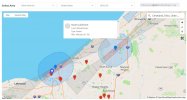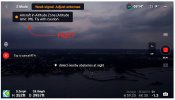FYI: I was using the Alien Mini Antennas System which I think are Omni Directional , different than the Stock ones.
The stock ones are flat blades, whereas the Aliens are cylindrical, correct. The signal radiates out from the surface of the antenna, very little from the tip of the antenna. The difference is the flat blades tend to focus the beam out either side of the flat surfaces (forward or backward), not so much out the edges. The cylindrical "Omni directional" antenna sends the signal out equally in all directions out the circular sides of the cylinder, but still very little out the tip. It's a donut shape.
See:
Wikipedia Omnidirectional Antenna
The benefit of an omni directional antenna is that, as long as the antenna is standing vertically straight up, the signal radiates equally in every direction to the horizon. You don't need to worry as much about keeping a focused beam "aimed" at the aircraft. However, you only need to be aware that if the antenna is pointing straight up, then straight above you is where the signal is weakest.
The omni directional advantage of the cylindrical antenna is also its biggest disadvantage. Because the signal is radiated
equally in every direction toward the horizon, the signal gets significantly weaker the further away it goes. An antenna of similar power, but which focuses a narrow beam in one direction, will extend much further but must then be kept carefully aimed at the aircraft.
That's the antenna on the transmitter. You also need to consider the antenna on the aircraft. I believe those are standing vertically in the front legs of the Mavic. The worst reception would be with the transmitter antenna standing vertically and the Mavic directly above you, as then both the transmitter and receiver antennas would be oriented tip-to-tip.
I don't know why you are getting a weak signal at that exact range (5000ft), coming back but not on the way out, or on the way out on your first flight. I still think it's just a coincidence that the edge of the Geo Altitude Zone is located right at that range, and I suspect the tall trees between you and the aircraft are to blame.
I see you've fixed the antennae so they're standing straight up this time. That alone will have made a significant improvement over their floppy misaligned positioning in your first flight. I still think it's an antenna issue totally unrelated to the Geo Altitude Zone.
From your takeoff location to the far edge of the Geo Altitude Zone is almost exactly 5000 ft, and you can see how far along the beach that zone extends.
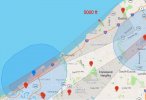
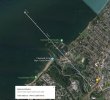
You've flown before from the parking lot of Wildwood Park. From there, you have a better unobstructed path for the antenna signal, and the same outer edge of the Altitude Zone would be only 3000 ft away.
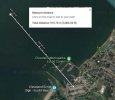
Try flying from the parking lot. I'll bet you get much better range without the signal loss at the edge of the GEO zone.
The warning message for the "Altitude Zone nearby (150m)" is still the same issue as before. As long as you stay below the 150m (492ft) ceiling you should have no problem. That altitude warning is still only indirectly related to the weak control signal warning, same as before.
If you have a strong signal and remain below the GEO zone ceiling, there'd be no issue. But if the signal is lost completely and if the drone's RTH height were configured higher than 150m (492ft), then it wouldn't be able to come home by itself because the GEO zone would stop it dead the moment it hit the outer edge of that zone. The other scrolling messages give ever more dire warnings saying the drone would stop and hover at that edge until the battery ran out (or you managed to regain control signal) and it would eventually auto-land with low battery in the lake.
People get into trouble with these Geo Zones if they don't know they're there and somehow get stuck on the far side of a restricted zone. You fly out and around the zone, then try to fly a straight line home, and the drone bumps up against an invisible wall and refuses to come back. If you know what's there and know how to steer around it, no problem. But if it's a mystery, that's when panic sets in. Eventually the battery runs dry, then it's bye-bye.



